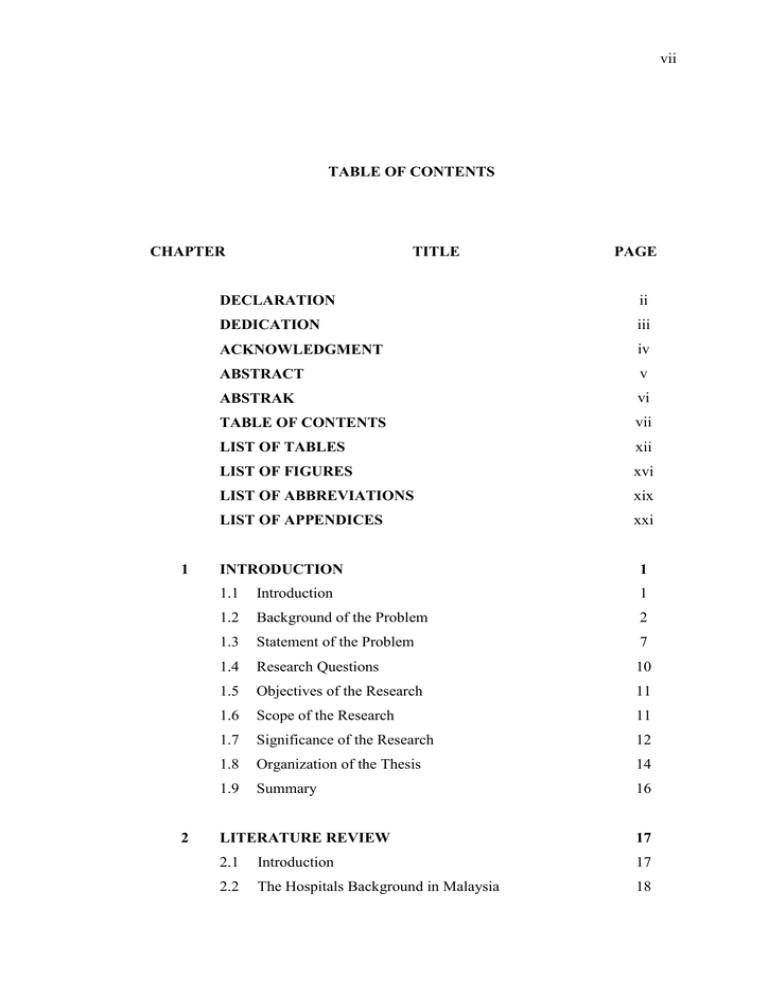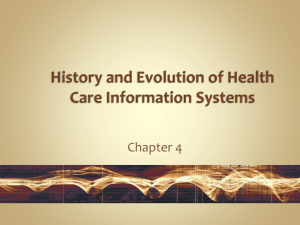vii ii iii
advertisement

vii TABLE OF CONTENTS CHAPTER 1 2 TITLE PAGE DECLARATION ii DEDICATION iii ACKNOWLEDGMENT iv ABSTRACT v ABSTRAK vi TABLE OF CONTENTS vii LIST OF TABLES xii LIST OF FIGURES xvi LIST OF ABBREVIATIONS xix LIST OF APPENDICES xxi INTRODUCTION 1 1.1 Introduction 1 1.2 Background of the Problem 2 1.3 Statement of the Problem 7 1.4 Research Questions 10 1.5 Objectives of the Research 11 1.6 Scope of the Research 11 1.7 Significance of the Research 12 1.8 Organization of the Thesis 14 1.9 Summary 16 LITERATURE REVIEW 17 2.1 Introduction 17 2.2 The Hospitals Background in Malaysia 18 viii 2.2.1 The Malaysian Healthcare Organization 20 2.2.2 Issues with Malaysian Healthcare Organization 20 Hospital Information System (HIS) 22 2.3.1 Definition of HIS 22 2.3.2 Categories of HIS 25 2.3.3 ICT Integration through HIS 28 2.3.4 HIS in Malaysia 29 2.4 The Current State of HIS in Healthcare 31 2.5 Adoption of HIS 37 2.6 Previous Researches on HIS Adoption 37 2.7 Literature on Innovation Adoption 41 2.8 Innovation Adoption in Organizations 42 2.9 Adoption Gap 43 2.3 2.10 Adoption Theories in IS Domain 2.10.1 Diffusion of Innovation Theory 2.10.2 Technology-Organization-Environment Framework 43 46 49 2.10.2.1 Critical Analysis of TOE Framework in Health Information System Domain 3 54 2.10.3 Institutional Theory 56 2.10.4 Human-Organization-Technology Fit Model 63 2.11 Comparison of Selected Theories 65 2.12 Factors Related to the HIS Adoption 68 2.13 Summary 71 RESEARCH METHODOLOGY 73 3.1 Introduction 73 3.2 The Selected IS Theory Usage 74 3.3 Epistemology 75 3.3.1 76 Positivist Epistemology 3.4 Research Approach 78 3.5 Research Design 80 ix 3.6 3.7 4 3.5.1 Stage 1: Define Research Problem 3.5.2 Stages 2 and 3: Literature Review and Propose 82 Research Framework 82 3.5.3 Stage 4: Ethics Application 83 3.5.4 Stage 5: Questionnaire Development and Validation 84 3.5.4.1 Target Population 86 3.5.4.2 Design and Write Questionnaire 88 Pilot Survey 103 3.6.1 Content Validity 105 3.6.2 Descriptive Analysis of Samples in Pilot Survey 106 3.6.3 Construct Reliability 108 3.6.4 Construct Validity 110 The Survey 117 3.7.1 Questionnaire Distribution 118 3.7.2 Survey Data Analysis 119 3.8 Thesis Completion 122 3.9 Summary 124 INTEGRATED HOSPITAL INFORMATION SYSTEM ADOPTION FRAMEWORK 125 4.1 Introduction 125 4.2 Proposing an Integrated Hospital Information System Adoption Framework 4.2.1 An Initial Integrated Theoretical Framework for HIS Adoption 4.3 126 126 Research Hypotheses 127 4.3.1 Technological Dimension 129 4.3.1.1 Relative Advantage of HIS 129 4.3.1.2 Compatibility of HIS 131 4.3.1.3 Complexity of HIS 132 4.3.1.4 HIS Security Concern 133 x 4.3.2 4.3.3 4.3.4 Organizational Dimension 134 4.3.2.1 IS Infrastructure 135 4.3.2.2 Top Management Support 136 4.3.2.3 Hospital Size 137 4.3.2.4 Financial Resources 137 Environmental Dimension 139 4.3.3.1 Mimetic Pressure-Competitors 140 4.3.3.2 Coercive Pressure-Government 142 4.3.3.3 Vendor Support 143 Human Dimension 4.3.4.1 4.3.4.2 4.3.5 5 144 Perceived Technical Competence of IS Staff 144 Employees‘ IS Knowledge 145 Moderator Variable: Hospital Size 147 4.4 Dependent Variable: HIS Adoption 150 4.5 Variables Definition 152 4.6 Summary 153 FINDINGS AND DISCUSSION 155 5.1 Introduction 155 5.2 Descriptive Analysis of Respondents 155 5.2.1 Gender of Respondents 157 5.2.2 Age of Respondents 157 5.2.3 Position of Respondents 158 5.2.4 Years of Experience with the Current Position 159 5.2.5 Years of Experience in the Healthcare Industry 160 5.2.6 Number of Beds 161 Assessment of Measurement Model 162 5.3.1 Construct Reliability 163 5.3 5.3.1.1 Internal Consistency 163 5.3.1.2 Indicator Reliability 164 5.3.2 Construct Validity 5.3.2.1 Convergent Validity 168 168 xi 5.3.2.2 5.4 169 Data Descriptive Analysis 175 5.4.1 Simple Two-way Bar Charts 175 Data Analysis for Hypotheses Testing 187 5.5.1 Bernoulli variable 188 5.5.2 Logistic Regression Models 191 5.5.3 Evaluation of Moderator 217 5.6 Results of Research Hypotheses Testing 241 5.7 Summary 257 5.5 6 Discriminant Validity CONCLUSION AND FUTURE WORK 259 6.1 Introduction 259 6.2 Comparison of the Relevant Frameworks 259 6.3 Summary of Major Findings 260 6.4 Research Contributions 262 6.4.1 Theoretical Contributions 263 6.4.2 Practical Contributions 265 6.4.3 Practical Implications 265 6.5 Limitations of Research 271 6.6 Suggestions for Future Research 272 REFERENCES 274 Appendices A - C 301-313 xii LIST OF TABLES TABLE NO. 2.1 TITLE PAGE HIS components and their functions, departments and users of the component 24 2.2 Three HIS categories 26 2.3 Summary of reviewed studies of HIS in Malaysian context 30 2.4 Healthcare technology initiatives around the world 32 2.5 HIS adoption by individuals/organizations 39 2.6 Innovation characteristics 47 2.7 Research using TOE framework in IS domains 52 2.8 Summary of prior studies using TOE framework in healthcare information system domain 2.9 55 Research using institutional theory in IS domains with respect to healthcare 2.10 61 Review of prior studies using TOE with institutional theory and HOT-fit model 2.11 66 Summary of variables results by theories/models with respect to HIS adoption 69 3.1 A taxonomy of theory types in IS research 74 3.2 Epistemology categorization 75 3.3 The process of questionnaire development and validation 3.4 Number 85 of Malaysian public hospitals under Malaysian MOH based on each state 87 3.5 Measurement items of technological factors 91 3.6 Measurement items of organizational factors 93 xiii 3.7 Measurement items of environmental factors 94 3.8 Measurement items of human factors 95 3.9 Measurement items of HIS adoption 96 3.10 Guidelines for choosing the measurement model mode 3.11 98 Summary of specifying reflective and formative constructs 101 3.12 Construct operationalization by previous studies 102 3.13 Frequencies and percentages of respondents in pilot survey 3.14 107 Internal consistency of the reflective constructs / subconstructs 109 3.15 Item loading of indicators 110 3.16 Convergent validity of the reflective constructs / subconstructs 111 3.17 Discriminant validity based on cross-loadings matrix 113 3.18 Discriminant validity based on Fornell-Larker criterion 116 3.19 Summary of stage six (the survey) 117 4.1 Summary of proposed hypotheses 148 4.2 Explanation of variables 153 5.1 Frequencies and percentages of respondents based on gender 5.2 Frequencies and percentages of respondents based on age 5.3 160 Frequencies and percentages of respondents based years of experience in the healthcare industry 5.6 159 Frequencies and percentages of respondents based years of experience with the current position 5.5 158 Frequencies and percentages of respondents based on position 5.4 157 161 Frequencies and percentages of respondents based number of beds 162 xiv 5.7 Internal consistency of the reflective constructs / subconstructs 5.8 164 Outer loadings of the reflective constructs / subconstructs 5.9 166 Convergent validity of the reflective constructs / subconstructs 169 5.10 Discriminant validity based on cross-loadings matrix 171 5.11 Discriminant validity based on Fornell-Larker criterion 174 5.12 Case-processing summary 192 5.13 Variables in the equation for H1 192 5.14 Variables in the equation for H2 196 5.15 Variables in the equation for H3 198 5.16 Variables in the equation for H4 199 5.17 Variables in the equation for H5 202 5.18 Variables in the equation for H6 202 5.19 Variables in the equation for H7 203 5.20 Variables in the equation for H8 205 5.21 Variables in the equation for H9 206 5.22 Variables in the equation for H10 209 5.23 Variables in the equation for H11 209 5.24 Variables in the equation for H12 212 5.25 Variables in the equation for H13 215 5.26 Variables in the equation for relative advantage 219 5.27 Variables in the equation for compatibility 221 5.28 Variables in the equation for complexity 223 5.29 Variables in the equation for security concern 225 5.30 Variables in the equation for IS infrastructure 227 5.31 Variables in the equation for top management support 228 5.32 Variables in the equation for financial resources 230 5.33 Variables in the equation for mimetic pressurecompetitors 5.34 Variables in the equation for coercive pressure- 232 xv government 233 5.35 Variables in the equation for vendor support 235 5.36 Variables in the equation for perceived technical competence of IS staff 5.37 5.38 237 Variables in the equation for employees‘ IS knowledge 239 Summary of hypotheses testing 241 xvi LIST OF FIGURES FIGURE NO. TITLE PAGE 2.1 Malaysian healthcare organization structure 21 2.2 EHR adoption by U.S. physicians by year 33 2.3 The TOE Framework 49 2.4 Theoretical model of IS innovation based on institutional perspective 60 2.5 HOT-fit Model 63 3.1 The operational framework 81 3.2 Key inputs of design and write questionnaire 89 3.3 Overall process of data analysis 123 4.1 Proposed initial integrated theoretical framework for HIS adoption 4.2 128 The initial integrated theoretical framework and hypotheses 149 5.1 Process of data analysis 156 5.2 Distribution of four items of relative advantage variable in adopter and non-adopter hospitals 5.3 Distribution of four items of compatibility variable in adopter and non-adopter hospitals 5.4 179 Distribution of two items of IS infrastructure variable in adopter and non-adopter hospitals 5.7 178 Distribution of three items of security concern variable in adopter and non-adopter hospitals 5.6 177 Distribution of three items of complexity variable in adopter and non-adopter hospitals 5.5 176 Distribution of three items of top management 180 xvii support variable in adopter and non-adopter hospitals 5.8 Distribution of three categories of hospital size variable in adopter and non-adopter hospitals 5.9 181 Distribution of three items of financial resources variable in adopter and non-adopter hospitals 5.10 181 182 Distribution of six items of mimetic pressurecompetitors variable in adopter and non-adopter hospitals 5.11 183 Distribution of three items of coercive pressuregovernment variable in adopter and non-adopter hospitals 5.12 Distribution of three items of vendor support variable in adopter and non-adopter hospitals 5.13 184 185 Distribution of three items of perceived technical competence of IS staff variable in adopter and non-adopter hospitals 5.14 186 Distribution of three items of employees' IS knowledge variable in adopter and non-adopter hospitals 187 5.15 Logistic regression transformations 190 5.16 Plot test for relative advantage 220 5.17 Plot test for compatibility 222 5.18 Plot test for complexity 224 5.19 Plot test for security concern 226 5.20 Plot test for IS infrastructure 227 5.21 Plot test for top management support 229 5.22 Plot test for financial resources 231 5.23 Plot test for mimetic pressure-competitors 232 5.24 Plot test for coercive pressure-government 234 5.25 Plot test for vendor support 236 5.26 Plot test for perceived technical competence of IS staff 238 xviii 5.27 Plot test for employees‘ IS knowledge 5.28 Hypotheses testing results in the proposed initial integrated theoretical framework 240 242 xix LIST OF ABBREVIATIONS AHA - American Hospital Association AVE - Average Variance Extracted CIS - Clinical Information System CPOE - Computerized Physician Order Entry DOI - Diffusion of Innovation EAI - Enterprise Application Integration EHR - Electronic Health Record EMR - Electronic Medical Record FEDI - Financial Electronic Data Interchange FIS - Financial Information System FIS - Fundus Imaging System HAART - Highly Active Antiretroviral Therapy HIE - Health Information Exchange HIS - Hospital Information System HLS - Health Level Seven HOT - Human-Organization-Technology ICT - Information and Communication Technology IDT - Innovation Diffusion Theory IHISAF - Integrated Hospital Information System Adoption Framework IHSR - Institute for Health System Research IS - Information System IT - Information Technology LHP - Lifetime Health Plan LIS - Laboratory Information System MMRS - Mosoroit Medical Record System MNIS - Mobile Nursing Information Systems xx MOH - Ministry of Health MREC - Medical Research Ethics Committee MSC - Multimedia Super Corridor NEHAP - National Environmental Health Action Plan NIH - National Institute of Health NIS - Nursing Information System NMRR - National Medical Research Register PACS - Picture Archiving and Communication System PHR - Patient Health Record PIS - Pharmacy Information System PLS - Partial Least Square RFID - Radio Frequency Identification RIS - Radiology Information System SPSS - Statistical Package for the Social Sciences β - Regression Coefficient TAM - Technology Acceptance Model TOE - Technology-Organization-Environment TPB - Theory of Planned Behavior U.S. - United States - Independent Variable xxi LIST OF APPENDICES APPENDIX TITLE PAGE A Permission Letter for Research 301 B Survey Questionnaire 306 C Researchers‘ Profile in Content Validity Test 313



